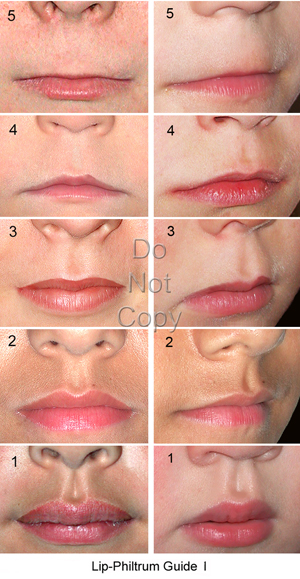
The Rank 5 picture portrays a philtrum that is completely smooth and an upper lip that is very thin (characteristic of FAS). The philtrum is the vertical groove between the nose and upper lip. The Rank 1 picture portrays a deeply grooved philtrum and very thick upper lip. As you advance up the Guide from Rank #1 to #5, the upper lip becomes thinner and the philtrum becomes smoother. The Lip-Philtrum Guide reflects the full range (or normal distribution) of lip thickness and philtrum depth one would see in a general population. The Rank 3 picture reflects the population mean (or 50th percentile). Ranks 1 and 5 reflect the extreme ends of the normal curve The Lip-Philtrum Guides are intended for use by medical professionals.
The Lip-Philtrum Guides are distributed as digital images free of charge. The digital image format is to be used on a mobile phone or computer tablet. These images are available free of charge and can be obtained by emailing Susan (Astley) Hemingway, PhD astley@uw.edu or completing and submitting our Order Form. The Digital Image Format of Lip-Philtrum Guides 1 and 2. The digital image format of Lip-Philtrum Guides 1 and 2 are displayed below. They come with a frontal and 3/4 view of the lips and philtrums. The 3/4 view images help to further portray the distinctions beween the 5 philtrum ranks. The frontal photos are used to rank lip thinness. The frontal and 3/4 view photos are used to rank philtrum smoothness. These digital images are intended to be loaded on a smartphone or computer tablet; devices that are small enough to hold next to the patient's face when you measure their features. Please do not print these digital images. Printing will invalidate the digital Lip-Philtrum Guides. If you print the digital guides, we cannot ensure your printer will provide the required image quality to ensure the tool's validity. For example, there are very subtle differences between the Rank 4 and Rank 5 philtrums. Not all printers will capture this subtle difference. The images are also invalidated if the height-to-width ratio of the Guide is altered. The square printed on the digital guide helps ensure the height-to-width ratio of the Guide is correct. If the square looks retangular in shape, the aspect ratio of the Guide has been altered rendering the guide invalid.
|
|||||||
Physician using Lip-Philtrum Guide. Illustration of a physician aligned in the patient's frankfort horizontal plane while using the Lip-Philtrum Guide to rank upper lip thinness and philtrum smoothness. The frankfort horizontal plane is defined by a line (green line) that passes through the patient's external auditory canal and the lowest border of the bony orbital rim (orbitale). The physician's eyes (or camera lens) should be directly in line with this plane. If the physician stood above this plane looking down on the patient, the patient's upper lip could appear thinner than it truly is. Click here to see an animation demonstrating how to align yourself in the patient's frankfort horizontal plane. |
Guide 1 |
Guide 2 |
|||||
Copyright: Please do not use these Lip-Philtrum Guide images without written permission from Susan (Astley) Hemingway, Ph.D. |
|||||||
| Click here to view instructional photos for how to correctly identify and differentiate Rank 4 and Rank 5 philtrums. | |||||||
A Smile Can Distort the Lip and Philtrum This is the same person with and without a smile. Note that without a smile, the lip and philtrum would both receive a correct Likert Rank of #2 on the Caucasian Lip-Philtrum Guide. With a smile, the lip and philtrum would both receive an incorrect Likert Rank of #5. |
 |
||||||
| Back to Top | |||||||



















